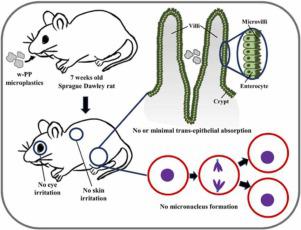Ecotoxicology and Environmental Safety ( IF 6.2 ) Pub Date : 2021-11-11 , DOI: 10.1016/j.ecoenv.2021.112964 Jinsik Kim 1 , Muthuchamy Maruthupandy 2 , Kyu Sup An 1 , Kwang Hun Lee 1 , Soyeon Jeon 2 , Ji-Su Kim 3 , Wan-Seob Cho 2

|
Polypropylene (PP) is the second most highly produced plastic worldwide, and its microplastic forms are found in water and food matrices. However, the effects of PP microplastics on human health remain largely unknown. Here, we prepared 85.2 µm-sized weathered PP (w-PP) microplastics by sieving the microplastic particles after fragmentation and accelerated weathering processes. The prepared particles are irregular in shape and no chemical additives including phthalates and bisphenol A were not released in simulated body fluids. Then, the w-PP samples were gavaged to rats for acute and subacute toxicity testing in accordance to the Organization for Economic Co-operation and Development (OECD) test guidelines under good laboratory practice regulations. The highest dose for gavaging to rats was 25 mg/kg bw/day, which was the maximum feasible dose based on the dispersibility of microplastics. Both toxicity testings for w-PP microplastics showed no adverse effects and mutagenicity. Thus, the no observed adverse effect level (NOAEL) of w-PP microplastics is higher than 25 mg/kg bw/day. Furthermore, the w-PP microplastics did not show any skin or eye irritation potentials in the 3-dimensional reconstructed human skin or corneal culture model. The dose of 25 mg/kg of w-PP microplastics is roughly equal to 2.82 × 105 particles/kg, which suggests that human exposure to w-PP microplastics in a real-life situation may not have any adverse effects.
中文翻译:

碎片微塑料对 Sprague-Dawley 大鼠的急性和亚急性重复口服毒性研究
聚丙烯 (PP) 是全球产量第二高的塑料,其微塑料形式存在于水和食物基质中。然而,PP微塑料对人类健康的影响在很大程度上仍然未知。在这里,我们通过在破碎和加速风化过程后筛分微塑料颗粒,制备了 85.2 µm 大小的风化 PP (w-PP) 微塑料。制备的颗粒形状不规则,模拟体液中未释放邻苯二甲酸盐和双酚A等化学添加剂。然后,根据经济合作与发展组织 (OECD) 测试指南下的良好实验室规范,将 w-PP 样品灌胃给大鼠进行急性和亚急性毒性测试。给大鼠灌胃的最高剂量为 25 毫克/千克体重/天,这是基于微塑料的分散性的最大可行剂量。w-PP 微塑料的两项毒性测试均未显示出不良影响和致突变性。因此,w-PP 微塑料的未观察到的不良反应水平 (NOAEL) 高于 25 毫克/千克体重/天。此外,w-PP 微塑料在 3 维重建的人体皮肤或角膜培养模型中没有表现出任何皮肤或眼睛刺激潜力。25mg/kg w-PP微塑料的剂量大致等于2.82×10 在 3 维重建的人体皮肤或角膜培养模型中,w-PP 微塑料没有显示任何皮肤或眼睛刺激潜力。25mg/kg w-PP微塑料的剂量大致等于2.82×10 在 3 维重建的人体皮肤或角膜培养模型中,w-PP 微塑料没有显示任何皮肤或眼睛刺激潜力。25mg/kg w-PP微塑料的剂量大致等于2.82×105颗粒/公斤,这表明人类在现实生活中接触 w-PP 微塑料可能不会产生任何不利影响。






































 京公网安备 11010802027423号
京公网安备 11010802027423号